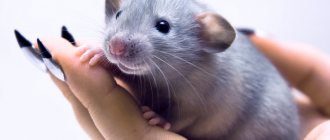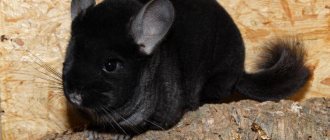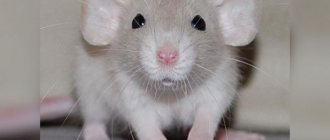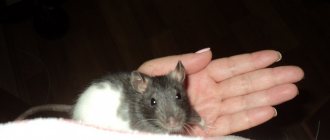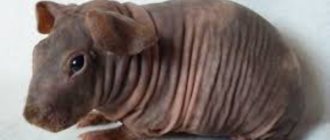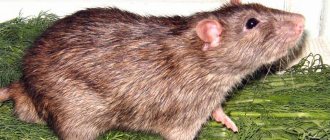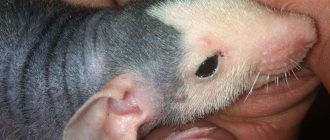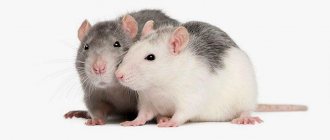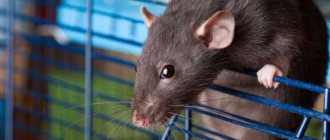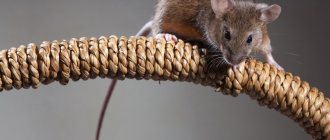Sphynxes are considered intellectuals among decorative rats, and their level of mental development is only slightly less than human. Therefore, it is not surprising that their popularity is rapidly growing, especially since they are also hypoallergenic.
Before getting such a difficult pet, it is important to learn how to properly care for a hairless Sphynx rat, what to feed it and how to protect it from diseases.
Types of decorative rats
There are different breeds of decorative rats. According to the type of wool they are divided into:
- standard, with short and smooth pile;
- rexes with mustaches and wavy fur;
- satin - with shiny silky fur;
- sphinxes are naked rats;
- Dumbo - individuals are distinguished by round, low-set ears, reminiscent of Mickey Mouse.
Animal colors are divided into subspecies:
- homogeneous: there are pure black, white, chocolate, blue, albino and others;
- heterogeneous: rats have Siamese, Himalayan, sable, silver and other colors;
- variegated: composed of several colors.
Varieties
Thanks to breeding work, several varieties of domestic dumbo rats have been developed. They differ in color and coat type.
Rex
Dumbo Rex rats have thick, curly fur. The cover is soft and silky. Little rats' fur does not curl, but sticks out in different directions, it looks very funny. In adult pets, formed curls can be seen. Mustaches can also curl.
Siamese
This is a very beautiful and rare variety with an original color, like a Siamese cat. The main shade of six is cream. There is a dark mask on the face and paws.
The gene that is responsible for this type of color is recessive, so it is passed on only to some cubs from the litter. This explains the high cost of Siamese rat pups.
Husky
Dumbo Husky rats are very popular. Pets with this color have dark fur of gray, brown or almost black color. As the animal grows, snow-white hairs appear, which are concentrated in the muzzle area, on the neck and abdomen.
Blue
Decorative blue Dumbo rats are very beautiful, so breeders often sell them at a higher price. These pets have light gray fur with a distinct bluish tint.
Manx
Domestic Dumbo Manx rats are the result of complex genetic mutations. This variety differs from others not in the type of coat or color, but in the absence of a tail.
Although the animal looks funny, life is hard for him without a tail. This part of the body is necessary to maintain balance. It also plays an important role in thermoregulation - the tailless rat often suffers from overheating. Therefore, for reasons of humanity, veterinarians are against breeding Manx cats.
Sphinx
These are unique representatives of the species that differ from their relatives in the absence of hair. The hairless Dumbo rat has numerous folds on its skin, like cats of the same breed. The vibrissae are underdeveloped and curled, but the standard allows for their absence.
Dumbo Sphinx rats require special housing conditions, as they are susceptible to colds and often suffer from skin damage.
Keeping decorative rats
Domestic decorative rats are rodents; they are cared for and kept in metal cages, because they are the strongest and most durable. It is better not to keep animals in plastic and wooden structures. It is also not recommended to place them in aquariums - they are difficult to clean, and the animals jump to a height of 40-50 cm and can escape. The house is installed in a place where there is no direct sunlight and draft, from which a rat can contract pneumonia. There is no need to place a home near the battery - dry air is harmful to animals. Optimum temperature +18-20°C.
For a decorative rat, the cage should have a size of 60x40x30 (for growth); often the house has two floors. Inside the home you need to install:
- a plastic tray with filler (preferably dry wood granules. Small sawdust can cause allergies in rats by getting into their eyes and nose. Newsprint contains harmful substances and is not suitable for use as bedding);
- stairs and tunnels, a wheel (animals love to play);
- plastic house for privacy;
- mineral stone for rodents (they sharpen their teeth);
- drinking bowl;
- 1-2 bowls;
- a cloth for sleeping or a hammock.
How to care for a decorative rat?
If decorative rats live in the house, care and maintenance of them include indispensable cleaning of the cage. Drinkers and bowls need to be washed daily, remove soiled or wet bedding, food debris, and change the filler in the tray. The cage and all household items must be systematically disinfected. If you carefully care for your decorative rat, the smell from it will be almost invisible. The animals are unpretentious and easily adapt to any environmental conditions. You can sometimes let them out for a walk, but you need to keep an eye on the pet so that it doesn’t chew on valuables.
Is it possible to bathe decorative rats?
Decorative domestic rats are neat and clean animals; keeping babies requires mandatory bathing. The procedure is carried out if the animal itches or has an unpleasant odor. Shampoo from a pet store will help deal with it. For bathing, prepare a container with heated water. They put the animal in it and wash it with their hands. In this case, the rodent may scratch and bite, but some people like this procedure. When bathing, you need to pay attention so that water does not get into the rat’s ears and nose. After the procedure is completed, the animal is dried with a towel.
Breeding
Female Sphynx cats go into heat weekly. When kept at home, rats actively breed. If one of a pair of animals is sick, it is better to postpone breeding until it is cured and isolate the animal from its partner.
After the birth of the cubs, the owner should not take the babies in his arms. This necessity is dictated by the tendency of rodents to eat their offspring in the presence of foreign odors. After a month from birth, young rats are placed in separate housing.
Given their fragile health, the reproduction of these pets must be taken seriously. If offspring are not planned, they can be sterilized at a veterinary clinic.
The hairless variety of rats was originally bred for laboratory experiments, but accidentally escaped the scope of scientific experiments. Touching and funny animals have a huge advantage over other decorative pets - they are able to understand and subtly feel people.
With proper care and regular communication, sphinxes become kind and devoted friends and give their owners many bright emotions.
What to feed a decorative rat at home?
Care and maintenance of a rodent have its own nuances in nutrition. Although animals are unpretentious in food, their diet should contain as little fat as possible. Adults are fed 2 times a day, babies - 4 times. They also need clean and fresh water. What to feed a decorative rat at home:
- Grain base (wheat, oats, barley, corn, millet). High-quality balanced mixtures are sold in pet stores.
- Vegetables, fruits: white cabbage, carrots, bananas, cucumbers, apples, boiled potatoes, pumpkin, eggplants, grapes.
- Protein food (given once a week): a piece of boiled meat, cottage cheese, cheese, egg.
- Chicken bones: animals love to sharpen their teeth with them.
- In autumn and winter, it is recommended to give pets ready-made vitamins from a pet store.
Decorative rats - care and maintenance: what should not be given as food:
- chocolate, sweets, candies;
- raw beans or beans;
- smoked sausage;
- raw potatoes;
- chips;
- soda and sweet drinks;
- Brussels sprouts and red cabbage.
What grass can be given to decorative rats?
Greens should be present in the daily diet of rodents. What do decorative rats eat from grasses:
- dill;
- dandelion;
- parsley;
- cilantro;
- plantain;
- radish tops.
Description of character
Rats are intellectuals with a soul and are very attached to their owner. They need communication and attention, otherwise they will wither away. The character of domestic rats of the Dumbo breed is calmer and more reserved than the rest. They are not that active. Very sociable, freedom-loving and cheerful. Experts advise taking rat pups not from pet stores, but from breeders, when they are very young, then the pets grow up to be affectionate and trusting little animals. Dambiks are very clean. If their house is dirty, they take care of cleaning themselves.
Decorative rats - diseases
A healthy animal is always active, it has clear eyes and shiny fur. There should be no red spots around the rodent's eyes, nose and ears. Knowing what a decorative rat looks like when properly cared for in a healthy state, if abnormalities are detected, you should consult a doctor. Rodent diseases:
- Excessive tooth growth. Occurs due to insufficient grinding and using only soft food - a veterinarian can help.
- Mycoplasmosis. A bacterial disease, infection occurs through the air, leading to pneumonia. It is almost impossible to save the animal.
- Abscesses. Abscesses appear on the skin, the doctor opens them, treats them, and administers the necessary medications.
- Tumors. They can be benign or malignant; the decision to remove them is made by the veterinarian.
- External parasites are mites. Appear from an excess of protein foods. It is necessary to remove seeds, nuts, meat from the diet, and clean the home daily for 1-2 weeks.
Maintaining a sanitary regime and ensuring a balanced diet are the main conditions for proper maintenance and care of the animal. Some infectious and parasitic diseases are also dangerous for humans, so you need to monitor the behavior and appearance of the animals and maintain personal hygiene. If your pet has lost its appetite, become less active, or looks unusual, it is important to contact a veterinarian.
How to tame a decorative rat?
Decorative rats have pros and cons in their character. The first include openness to communication and intelligence. As soon as a little rat appears at home, he is immediately given a name and addressed to him when food is poured in. After three days, the rodent begins to respond to the nickname and recognize the owner. Then you can gradually accustom him to holding hands. After the animal finally gets used to its owner, it is released to walk around the apartment. The disadvantage of a pet is the desire to chew on something - this must be controlled.
Pros and cons of the breed
A distinctive feature of sphinxes is the ability to recognize the owner’s mood by voice. When communicating with your pet, you need to monitor your intonation and timbre so as not to scare the animal.
Table 1. Advantages and disadvantages of sphinxes
| Positive traits | Negative qualities |
| Hypoallergenic | Prone to depression if left alone |
| Cleanliness | Short life |
| No characteristic odor | |
| Desire to connect with a person | |
| High level of intelligence | |
| Attractive appearance |
Interesting! Among the purebred sphinxes there are individuals with multi-colored eyes. But most often the color of the pupils of animals is black, red or pink. Occasionally you come across sphinxes with khaki eyes.
Decorative rat - reproduction
Breeding of decorative rats is carried out using a pair of opposite-sex individuals aged 6 months. Girls weigh 200-400 g, they are nimble and neat. Boys - 450-600 g each, mostly clumsy and sloppy. The female's estrus repeats every 10 days. Mating is carried out for 1-4 hours in any territory - it does not matter with a girl or a boy. The female's pregnancy lasts 21 days, during which time she needs to eat more fruits and vegetables. Before giving birth, the expectant mother builds a nest - she drags out various materials (rags, toilet paper). The female gives birth to up to 8 rat pups weighing 5-7 g.
If a couple lives together, then at the time of birth the male must be separated so that he does not show aggression towards the babies. It is important for the mother in labor to have access to clean water so that she does not eat her offspring. The mother feeds the newborns for a month; from the third week of life they begin to try adult food. Babies' fur grows by 8-10 days, and their eyes open between 12 and 16 days. At the age of 1.5 months, the animals become completely independent and must be separated by gender or sold. After 12-18 months of life, females can no longer have offspring.
Training of decorative rats
There are many tricks that complement the natural habits of rodents and will bring pleasure to the owners. To do this, you will need a treat - a piece of meat, a pumpkin seed. How to train a decorative rat:
- Return to the cage. After the animal has taken root, it can be released for a walk around the apartment. It’s easy to return the animal: at the same time you need to sprinkle food, knock the bowl on the floor and call your pet - he will come running.
- “Sit” or “serve.” You need to hold the treat over the animal’s head and say the command. The rat will learn that it gets a treat after it stands on its hind legs and will follow the order to “sit” every time, even without a treat.
- Run in circles. You can move the treat along a trajectory and give it to the animal after it completes the trick. Also, with the help of treats, it is easy to teach a rat to run up stairs.
Choosing a name for Dumbo the rat?
The owners are trying to give the young, smart baby Dumbo a deep and meaningful nickname in the hope that the animal's name can influence the character and intelligence of the funny animal. Sometimes it can be difficult to immediately name a pet with a suitable name that emphasizes its individuality and expresses the love of its owner.
It is advisable to take a few days to take a closer look at the habits and character traits of the new family member; most likely, he himself will tell the owner what to call him. The furry baby's nickname can be tied to the color of the rodent's coat and funny ears, human associations from the pet's appearance and funny faces, favorite book and cartoon characters or pop stars. The rodent's nickname should be simple and easy to pronounce in a diminutive form. It is believed that females respond better to nicknames that begin with the letters K, M and D. Males are more fond of names with the letters S, K, M and D, long-eared pets are more willing to get used to nicknames with the letters T, N, L, M, K , S, Sh and R.
The name for a Dumbo rat girl can be: Knopa, Scully, Masya, Dana, Molly, Ksyusha, Marta, Alice, Dasha, Klava, Matilda, Gina, Darcy, Alpha, Kayla, Linda.
The name for a dumbo boy rat can be: Kuzya, Tyson, Tim, Rocky, Simson, Garik, Steve, Venya, Bucks, Rocky, Dick.
It doesn’t matter what the owner calls the smart-eared baby. In any case, the baby rat Dumbo will sincerely adore and faithfully wait for his beloved owner, giving him his incredible tenderness and selfless love.
